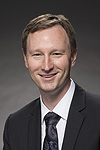Where did the tables go?
 |
|
Tim Meyer
|
If you were around the Wilson Hall cafeteria last week, you may have noticed that the large, round legacy tables were disassembled and taken away. Permanently? No. They are being restored and will return as part of the Atrium Modernization Project.
The fresh, new look that is coming to the Wilson Hall atrium includes a revised dining area in addition to the new state-of-the-art experimental operations center to be revealed next month. Modern seating, improved lighting, more flexible tables, improved waste and recycling handling and convenient access to electrical power are just some of the changes you will notice this fall.
When you sit down to have your free-range, all-organic, vegan, whole-grain, zero-carbon-footprint bean sprout sandwich (or something delicious from our superb cafeteria staff and their kitchens), you will have a variety of new seating venues to choose from. You'll also have more options to work, collaborate and socialize.
In addition to upgrading the cafeteria, we are examining ways to improve the restrooms in Wilson Hall and to upgrade conference rooms throughout the building, with the goal to modernize our facilities.
You may wonder: Wouldn't it be better to invest in new research equipment or additional staff instead of upgrading these facilities?
These trade-offs are not easy and are actually quite difficult decisions, but they are essential — absolutely crucial — for our future. If we want Fermilab to continue to be world-class, it has to look and feel world-class — to us and to those who visit the lab.
That goes for everything from how parking is organized for visitors to the sense of pride radiating from all of us when we look at the architecture and accomplishments of the laboratory. It's like the old adage that says if you want to know the quality of a restaurant's kitchen, take a look at the bathrooms. It will tell you a lot about how much the proprietors care about the environment in which they prepare and serve the food.
If we want our stakeholders and collaborators to support the lab's long-term future, we have to make choices that are consistent. Modern doesn't mean lavish or luxurious; in fact, modern often means lower consumption, improved reliability and better functionality.
From the much-needed Utilities Upgrade Project to upgrading the entrance gate guardhouses to changing the furniture in the cafeteria, Fermilab is moving forward, revitalizing our aging infrastructure.
Have an operations-related suggestion or comment? Send it to me via this online feedback form. I look forward to hearing from you!
|